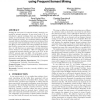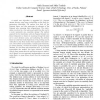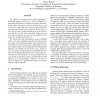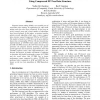KDD
2012
ACM
12 years 11 months ago
2012
ACM
In recent years, mining frequent itemsets over uncertain data has attracted much attention in the data mining community. Unlike the corresponding problem in deterministic data, th...
162
click to vote
ISMIS
2011
Springer
13 years 11 months ago
2011
Springer
Abstract. Frequent itemset mining can be regarded as advanced database querying where a user specifies the dataset to be mined and constraints to be satisfied by the discovered i...
CORR
2011
Springer
14 years 7 hour ago
2011
Springer
Abstract—Set intersection is the core in a variety of problems, e.g. frequent itemset mining and sparse boolean matrix multiplication. It is well-known that large speed gains can...
KAIS
2006
14 years 8 months ago
2006
Frequent itemset mining was initially proposed and has been studied extensively in the context of association rule mining. In recent years, several studies have also extended its a...
SIGCOMM
2010
ACM
14 years 8 months ago
2010
ACM
Finding the root-cause of a network security anomaly is essential for network operators. In our recent work [1, 5], we introduced a generic technique that uses frequent itemset mi...
FIMI
2003
14 years 9 months ago
2003
Existing association rule mining algorithms suffer from many problems when mining massive transactional datasets. Some of these major problems are: (1) the repetitive I/O disk sca...
FIMI
2003
14 years 9 months ago
2003
A simple new algorithm is suggested for frequent itemset mining, using item probabilities as the basis for generating candidates. The method first finds all the frequent items, an...
FIMI
2003
14 years 9 months ago
2003
The efficiency of frequent itemset mining algorithms is determined mainly by three factors: the way candidates are generated, the data structure that is used and the implementati...
FIMI
2004
14 years 9 months ago
2004
Frequent itemset mining (FIM) is an essential part of association rules mining. Its application for other data mining tasks has also been recognized. It has been an active researc...
FIMI
2004
14 years 9 months ago
2004
Trie is a popular data structure in frequent itemset mining (FIM) algorithms. It is memory-efficient, and allows fast construction and information retrieval. Many trie-related tec...




